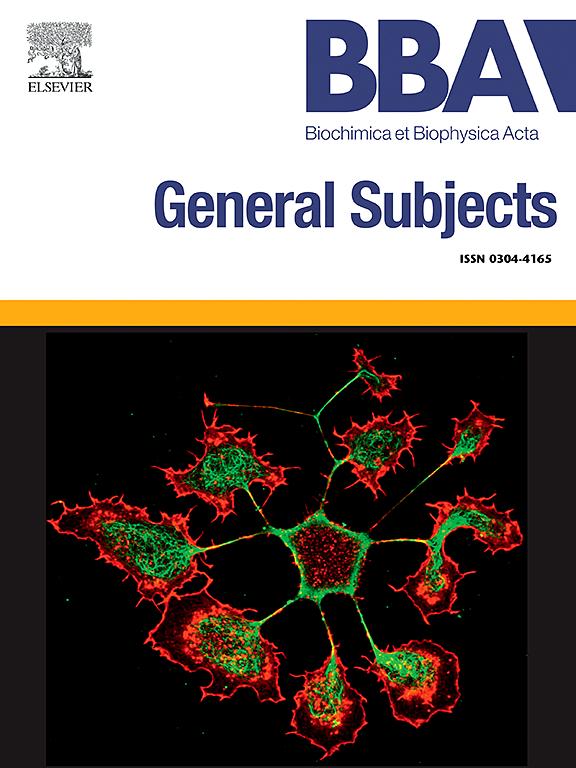STAT3-orchestrated gene expression signatures and tumor microenvironment in esophageal squamous cell carcinoma uncovered by single-cell sequencing
IF 2.2
3区 生物学
Q3 BIOCHEMISTRY & MOLECULAR BIOLOGY
Biochimica et biophysica acta. General subjects
Pub Date : 2025-03-09
DOI:10.1016/j.bbagen.2025.130791
引用次数: 0
Abstract
Background
The progression of Esophageal Squamous Cell Carcinoma (ESCC) can be dissected with greater precision using multi-omics and single-cell RNA sequencing (scRNA-seq) compared to traditional methodologies. These advanced approaches enable a comprehensive understanding of cellular heterogeneity and molecular dynamics, offering higher resolution insights into cancer development. Moreover, analyzing transcription factor regulatory networks provides innovative avenues for identifying cancer biomarkers and therapeutic targets, driving new perspectives in cancer research.
Objective
To explore the molecular mechanisms and cellular dynamics of ESCC.
Methods
Utilizing bulk-RNA-seq and single-cell transcriptomics, our study identify major cell types, transcriptomic gene and function changes during ESCC progression. Validation experiments in clinical sample tissues and ESCC cell lines to confirm core regulation factor in ESCC.
Results
We identified six major cell types in the ESCC scRNA-seq dataset and revealed profound shifts in cellular composition and transcriptional profiles. Notably, STAT3 was found to be a core regulator in ESCC and negatively regulated LHPP expression at promoter sites. Elevated STAT3 and reduced LHPP expression were consistently observed in patient samples, highlighting their inverse relationship in ESCC pathogenesis.
Conclusion
This study integrates bulk-seq and scRNA-seq data to reveal the pivotal role of STAT3 in ESCC. STAT3 negatively regulates LHPP expression, driving tumor progression. These findings underscore the therapeutic potential of targeting STAT3 in ESCC. Key words: ESCC, single-cell transcriptomics, ESCC microenvironment, STAT3.

单细胞测序揭示食管鳞状细胞癌中stat3调控的基因表达特征和肿瘤微环境
背景:与传统方法相比,使用多组学和单细胞RNA测序(scRNA-seq)可以更精确地解剖食管鳞状细胞癌(ESCC)的进展。这些先进的方法能够全面理解细胞异质性和分子动力学,为癌症发展提供更高分辨率的见解。此外,分析转录因子调控网络为识别癌症生物标志物和治疗靶点提供了创新途径,推动了癌症研究的新视角。目的:探讨ESCC的分子机制和细胞动力学。方法:利用bulk-RNA-seq和单细胞转录组学,研究ESCC进展过程中的主要细胞类型、转录组基因和功能变化。临床样本组织及ESCC细胞系验证实验,确认ESCC核心调控因子。结果:我们在ESCC scRNA-seq数据集中鉴定了六种主要的细胞类型,并揭示了细胞组成和转录谱的深刻变化。值得注意的是,STAT3被发现是ESCC的核心调控因子,并在启动子位点负调控LHPP的表达。在患者样本中一致观察到STAT3升高和LHPP表达降低,强调了它们在ESCC发病机制中的反比关系。结论:本研究整合了bulk-seq和scRNA-seq数据,揭示了STAT3在ESCC中的关键作用。STAT3负调控LHPP表达,推动肿瘤进展。这些发现强调了靶向STAT3治疗ESCC的潜力。关键词:ESCC,单细胞转录组学,ESCC微环境,STAT3
本文章由计算机程序翻译,如有差异,请以英文原文为准。
求助全文
约1分钟内获得全文
求助全文
来源期刊

Biochimica et biophysica acta. General subjects
生物-生化与分子生物学
CiteScore
6.40
自引率
0.00%
发文量
139
审稿时长
30 days
期刊介绍:
BBA General Subjects accepts for submission either original, hypothesis-driven studies or reviews covering subjects in biochemistry and biophysics that are considered to have general interest for a wide audience. Manuscripts with interdisciplinary approaches are especially encouraged.
 求助内容:
求助内容: 应助结果提醒方式:
应助结果提醒方式:


